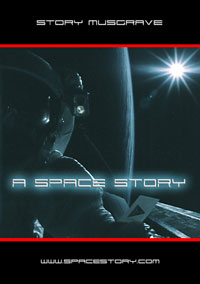Review: Musgrave’s space storyMonday, July 26, 2004A Space Story A NASA astronaut giving a presentation to members of the public usually falls into a basic stereotype. Wearing a blue flightsuit, he or she earnestly attempts to be outgoing and connect with the public, but often remains rooted to the space behind the podium. There is, of course, the slideshow of images of the Earth taken from the shuttle (and, more recently, ISS) missions, as well as the usual shots of astronauts living, working, and occasionally playing in weightlessness. The talk is usually followed by a question-and-answer period with the audience. It’s a time-honored formula that works reasonably well, although, given only the mild support that space exploration has among the general public, one wonders if NASA could do better. There are, of course, exceptions to this stereotype: current and former astronauts who have found ways to better communicate the wonders of space exploration to the general public. One example is Story Musgrave, a veteran of six shuttle missions in the 1980s and 1990s, including the STS-61 mission that repaired the Hubble Space Telescope in 1993. Billed as something of a renaissance man, with advanced degrees in medicine and literature, Musgrave has that rare combination of knowledge and experience as well as the ability to communicate it effectively. He puts those skills on display in the DVD A Space Story. The 80-minute DVD presents a lecture by Musgrave before an audience in Austin, Texas. “Lecture”, though, may not be the appropriate term. Instead of standing behind a podium and flipping through a set of slides, Musgrave moves about on a plain gray stage, rarely standing still for more than a few moments. Clad in gray slacks, a red turtleneck, and a blue blazer, with a microphone clipped around his ear, he looks more like a college professor, and acts more like a motivational speaker, than a former astronaut. There are, of course, many photos, and even a couple of props (such as a model of the Hubble Space Telescope suspended from the ceiling) to supplement the presentation, but Musgrave remains the centerpiece of the event.
The first half of A Space Story is devoted to Musgrave’s role on the STS-61 Hubble servicing mission. Musgrave goes through the whole process of training for the repair mission (including getting frostbite on his hands during one training session in a thermal vacuum chamber), then recounts the mission itself in considerable detail. Then, about halfway through the talk, he switches gears fairly abruptly, talking first about a test on an earlier mission of the properties of Coca-Cola in space, and then takes the audience on a trip around the world using images from space. This latter part is not unlike the views of Earth shown by other astronauts in their talks, but Musgrave gives a more passionate and poetic twist, leavened with an occasional bit of humor. A Space Story is not without some flaws. Virtually the entire video has a soundtrack of ethereal “space music” that becomes distracting at times. Musgrave’s voice varies in strength in the presentation from a boldly projected voice to almost a whisper; in the latter case it can be sometimes hard to hear him, particularly when the music is also playing. The transition in Musgrave’s talk from the Hubble mission to the earlier mission (with the Coke experiment) is very abrupt: in the course of just a few sentences he goes from discussing the melancholy he felt after completing the repairs, realizing that that particular phase of his career was now over, to going back to that earlier mission, with nothing obvious to bridge the two. It was a rare rough spot in an otherwise smoothly-delivered presentation. At the end of A Space Story, Musgrave has managed to instill a sense of wonder and appreciation of not just the cosmos, but the Earth itself, as viewed from space. Space aficionados will not necessarily learn much about spaceflight, the universe, or the Earth from the video, which is aimed more at the general public, but they will gain an appreciation of how to effectively communicate those concepts, getting beyond a dry recitation of facts and events and exploring these topics from a more personal, even lyrical standpoint. If there were more people who could do that like Story Musgrave, perhaps public interest in, and appreciation for, space exploration would be that much greater. Home |
|
